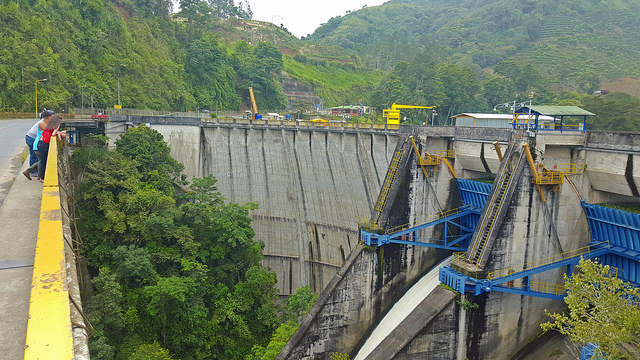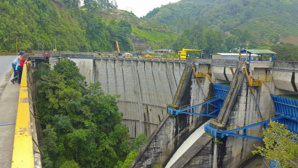Although Central America has an abundance of sunshine and wind it still depends on hydroelectricity and thermal power to generate its electricity needs. Although the region has since long tried to increase the proportion of renewable energies into its energy mix, it is still largely dependent on coal and fossil fuel enabled power plants.
“In general terms, the Central American region is not taking advantage of its potential, principally because investment channels have not been chosen,” said Javier Mejía, an official working at the Humboldt Centr e in Nicaragua.
He went on to explain that, unlike the megaprojects of the past, “solar and wind energy initiatives could be undertaken in isolated areas and could serve small population groups which the power grid has a hard time reaching.”
According to an analyses that appears in the upcoming Estado de la Región report, the region uses only 1% of its wind power potential. The report was, produced by the Consejo Nacional de Rectores (CONARE), which consists of Costa Rica’s four public universities.
As per a group of journalists who have accessed the report the countries of this region have two to three times more annual solar radiation than Germany, which is currently the global leader in solar power. Further, as much as 85% of the region’s geothermal power potential is unexplored, albeit much of it hard to access.
As per Mejía, who works at the Humboldt Centre, one of the weaknesses of this region is that “many countries depend on foreign investment that often gives rise to megaprojects which do not resolve the energy problem, and cause social and environmental damage.”
Clean energy has yet to set a foothold in this region, although countries here and there are beginning to lean towards it. For example, Costa Rica has invested heavily into renewable energy sources such that by the end of this calendar year, 97% of its energy will be generated by renewable energy. While Panama is increasingly becoming dependent on fossil fuel. El Salvador has tapped into its abundant geothermal energy while still largely depends on coal, the dirtiest source, to meet its energy requirements.
Although Central America’s greenhouse gas emissions make up 0.8% of the global total, however, given the challenges faced by humanity today, there is no option but to select and move towards cleaner energy sources.
As per the latest report by the Global Commission on the Economy and Climate 10 areas have been identified which are essentially low hanging fruits, and improvements in these 10 key regions could reduce carbon emissions from 59% to 96% by 2030. This will not only help keep the world’s rising temperatures at check below that of 2°C, but will also deliver huge economic benefits.
“Even though we are not the source of the main greenhouse gas emissions, there is a factor of vulnerability in terms of future supplies,” said Alberto Mora, the lead author of the Estado de la Región report.
In the absence of clear central policies, the Central American Alliance for Energy Sustainability (ACCESE), which is a civil society group that promotes the use of small-scale renewable energies and energy efficiency has led the generation of renewable energies at a community level.
“Renewable energies resolve the problem of the fossil fuel systems based on imported, polluting raw materials while at the same time facilitating access to energy for people who don’t have electric power,” said Melina Campos, ACCESE coordinator.
She went on to add that renewable energies have both an environmental and a human element. “This, I believe, is the heart of the matter.”
Source(s):
ipsnews.net
“In general terms, the Central American region is not taking advantage of its potential, principally because investment channels have not been chosen,” said Javier Mejía, an official working at the Humboldt Centr e in Nicaragua.
He went on to explain that, unlike the megaprojects of the past, “solar and wind energy initiatives could be undertaken in isolated areas and could serve small population groups which the power grid has a hard time reaching.”
According to an analyses that appears in the upcoming Estado de la Región report, the region uses only 1% of its wind power potential. The report was, produced by the Consejo Nacional de Rectores (CONARE), which consists of Costa Rica’s four public universities.
As per a group of journalists who have accessed the report the countries of this region have two to three times more annual solar radiation than Germany, which is currently the global leader in solar power. Further, as much as 85% of the region’s geothermal power potential is unexplored, albeit much of it hard to access.
As per Mejía, who works at the Humboldt Centre, one of the weaknesses of this region is that “many countries depend on foreign investment that often gives rise to megaprojects which do not resolve the energy problem, and cause social and environmental damage.”
Clean energy has yet to set a foothold in this region, although countries here and there are beginning to lean towards it. For example, Costa Rica has invested heavily into renewable energy sources such that by the end of this calendar year, 97% of its energy will be generated by renewable energy. While Panama is increasingly becoming dependent on fossil fuel. El Salvador has tapped into its abundant geothermal energy while still largely depends on coal, the dirtiest source, to meet its energy requirements.
Although Central America’s greenhouse gas emissions make up 0.8% of the global total, however, given the challenges faced by humanity today, there is no option but to select and move towards cleaner energy sources.
As per the latest report by the Global Commission on the Economy and Climate 10 areas have been identified which are essentially low hanging fruits, and improvements in these 10 key regions could reduce carbon emissions from 59% to 96% by 2030. This will not only help keep the world’s rising temperatures at check below that of 2°C, but will also deliver huge economic benefits.
“Even though we are not the source of the main greenhouse gas emissions, there is a factor of vulnerability in terms of future supplies,” said Alberto Mora, the lead author of the Estado de la Región report.
In the absence of clear central policies, the Central American Alliance for Energy Sustainability (ACCESE), which is a civil society group that promotes the use of small-scale renewable energies and energy efficiency has led the generation of renewable energies at a community level.
“Renewable energies resolve the problem of the fossil fuel systems based on imported, polluting raw materials while at the same time facilitating access to energy for people who don’t have electric power,” said Melina Campos, ACCESE coordinator.
She went on to add that renewable energies have both an environmental and a human element. “This, I believe, is the heart of the matter.”
Source(s):
ipsnews.net


 Central America is yet to capitalize on the abundance of its environment.
Central America is yet to capitalize on the abundance of its environment.





 Companies
Companies